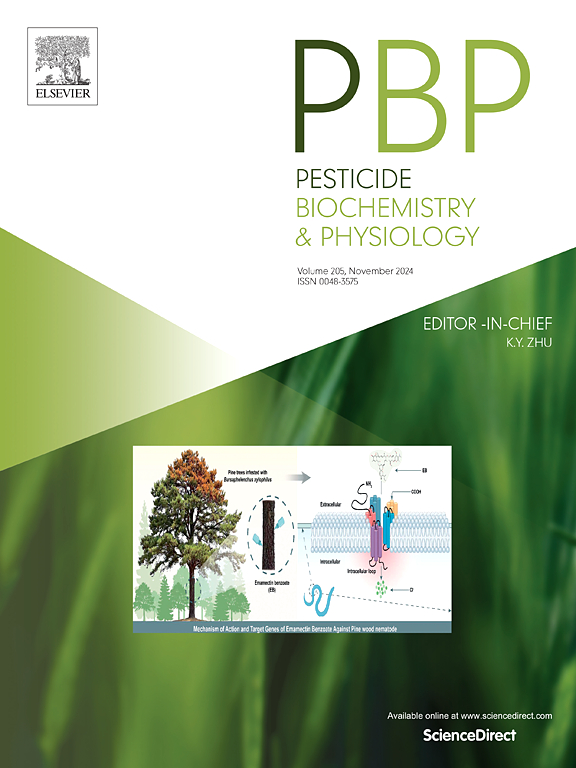Amisulbrom诱导人滋养细胞和子宫内膜细胞线粒体功能障碍,导致细胞凋亡和细胞周期阻滞
IF 4.2
1区 农林科学
Q2 BIOCHEMISTRY & MOLECULAR BIOLOGY
引用次数: 0
摘要
Amisulbrom是一种基于三唑的杀菌剂,用于农业,通过控制真菌感染来提高农业产量。磺胺溴的50%消失时间长(DT50),对非靶生物有潜在的毒性作用。然而,对怀孕过程的毒性影响尚不清楚。本研究旨在确定与amisulbrom暴露后植入相关的人滋养细胞(HTR-8/SVneo)和人子宫内膜细胞(T HESCs)的细胞毒性反应。线粒体功能障碍和细胞内Ca2+超载在暴露于amisulbrom的两个细胞中被确定。此外,amisulbrom阻滞G2/M期细胞周期进程,导致细胞凋亡,降低存活。过量的活性氧(ROS)积累和amisulbrom暴露介导PI3K/AKT信号蛋白的去磷酸化介导了这些毒性作用。此外,在三维悬滴培养模型中,amisulbrom处理抑制了球体的形成。这些结果表明,氨磺溴可能对植入过程产生不利影响。需要进一步的研究来确定氨磺溴的体内毒性。这是第一个对植入过程中氨磺溴可能的毒性机制提出关注的研究。本文章由计算机程序翻译,如有差异,请以英文原文为准。

Amisulbrom induces mitochondrial dysfunction, leading apoptosis and cell cycle arrest in human trophoblast and endometrial cells
Amisulbrom, a triazole-based fungicide, is utilized in agriculture to increase agricultural production by controlling fungal infections. The long disappearance time of 50 % (DT50) and potential toxic effects of amisulbrom on nontarget organisms have been reported. However, the toxic effects on the pregnancy process remain unclear. This study aims to determine the cytotoxic responses of human trophoblast cells (HTR-8/SVneo) and human endometrial cells (T HESCs), which are associated with implantation upon amisulbrom exposure. Mitochondrial dysfunction and intracellular Ca2+ overload were determined in both cells that are exposed to amisulbrom. Additionally, amisulbrom arrested the cell cycle progression in the G2/M phase, causing apoptosis and reduced survival. Excessive reactive oxygen species (ROS) accumulation and dephosphorylation of PI3K/AKT signaling proteins by amisulbrom exposure mediated these toxic effects. Additionally, spheroid formation was inhibited by amisulbrom treatment in the three-dimensional hanging drop culture model. These results indicate that amisulbrom may pose an adverse effect on the implantation process. Further research is required to identify the toxicity of amisulbrom in vivo. This is the first study to raise concerns about possible toxicity mechanisms of amisulbrom in the implantation process.
求助全文
通过发布文献求助,成功后即可免费获取论文全文。
去求助
来源期刊
CiteScore
7.00
自引率
8.50%
发文量
238
审稿时长
4.2 months
期刊介绍:
Pesticide Biochemistry and Physiology publishes original scientific articles pertaining to the mode of action of plant protection agents such as insecticides, fungicides, herbicides, and similar compounds, including nonlethal pest control agents, biosynthesis of pheromones, hormones, and plant resistance agents. Manuscripts may include a biochemical, physiological, or molecular study for an understanding of comparative toxicology or selective toxicity of both target and nontarget organisms. Particular interest will be given to studies on the molecular biology of pest control, toxicology, and pesticide resistance.
Research Areas Emphasized Include the Biochemistry and Physiology of:
• Comparative toxicity
• Mode of action
• Pathophysiology
• Plant growth regulators
• Resistance
• Other effects of pesticides on both parasites and hosts.

 求助内容:
求助内容: 应助结果提醒方式:
应助结果提醒方式:


